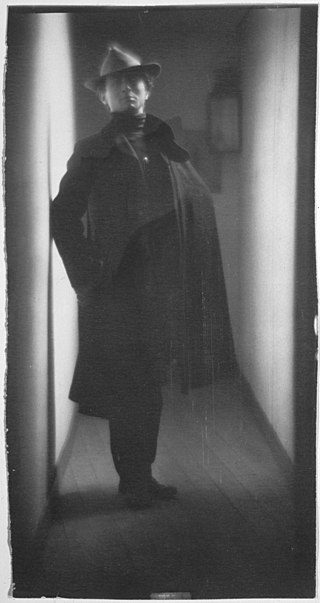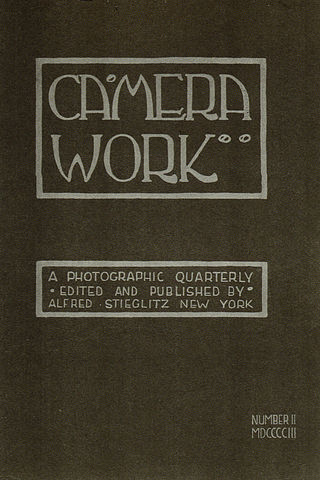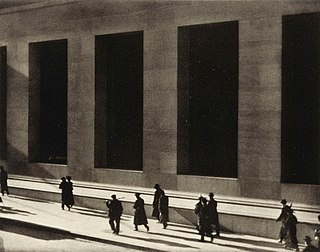
Ansel Easton Adams was an American landscape photographer and environmentalist known for his black-and-white images of the American West. He helped found Group f/64, an association of photographers advocating "pure" photography which favored sharp focus and the use of the full tonal range of a photograph. He and Fred Archer developed a system of image-making called the Zone System, a method of achieving a desired final print through a technical understanding of how the tonal range of an image is the result of choices made in exposure, negative development, and printing.

Pictorialism is an international style and aesthetic movement that dominated photography during the later 19th and early 20th centuries. There is no standard definition of the term, but in general it refers to a style in which the photographer has somehow manipulated what would otherwise be a straightforward photograph as a means of creating an image rather than simply recording it. Typically, a pictorial photograph appears to lack a sharp focus, is printed in one or more colors other than black-and-white and may have visible brush strokes or other manipulation of the surface. For the pictorialist, a photograph, like a painting, drawing or engraving, was a way of projecting an emotional intent into the viewer's realm of imagination.

Group f/64 or f.64 was a group founded by seven 20th-century San Francisco Bay Area photographers who shared a common photographic style characterized by sharply focused and carefully framed images seen through a particularly Western (U.S.) viewpoint. In part, they formed in opposition to the pictorialist photographic style that had dominated much of the early 20th century, but moreover, they wanted to promote a new modernist aesthetic that was based on precisely exposed images of natural forms and found objects.

Edward Henry Weston was a 20th-century American photographer. He has been called "one of the most innovative and influential American photographers" and "one of the masters of 20th century photography." Over the course of his 40-year career Weston photographed an increasingly expansive set of subjects, including landscapes, still lifes, nudes, portraits, genre scenes and even whimsical parodies. It is said that he developed a "quintessentially American, and especially Californian, approach to modern photography" because of his focus on the people and places of the American West. In 1937 Weston was the first photographer to receive a Guggenheim Fellowship, and over the next two years he produced nearly 1,400 negatives using his 8 × 10 view camera. Some of his most famous photographs were taken of the trees and rocks at Point Lobos, California, near where he lived for many years.

Alfred Stieglitz was an American photographer and modern art promoter who was instrumental over his 50-year career in making photography an accepted art form. In addition to his photography, Stieglitz was known for the New York art galleries that he ran in the early part of the 20th century, where he introduced many avant-garde European artists to the U.S. He was married to painter Georgia O'Keeffe.

Edward Jean Steichen was a Luxembourgish American photographer, painter, and curator, renowned as one of the most prolific and influential figures in the history of photography.

Paul Strand was an American photographer and filmmaker who, along with fellow modernist photographers like Alfred Stieglitz and Edward Weston, helped establish photography as an art form in the 20th century. In 1936, he helped found the Photo League, a cooperative of photographers who banded together around a range of common social and creative causes. His diverse body of work, spanning six decades, covers numerous genres and subjects throughout the Americas, Europe, and Africa.
291 is the commonly known name for an internationally famous art gallery that was located in Midtown Manhattan at 291 Fifth Avenue in New York City from 1905 to 1917. Originally called the "Little Galleries of the Photo-Secession", the gallery was established and managed by photographer Alfred Stieglitz.

Fine-art photography is photography created in line with the vision of the photographer as artist, using photography as a medium for creative expression. The goal of fine-art photography is to express an idea, a message, or an emotion. This stands in contrast to representational photography, such as photojournalism, which provides a documentary visual account of specific subjects and events, literally representing objective reality rather than the subjective intent of the photographer; and commercial photography, the primary focus of which is to advertise products, or services.

Nancy Wynne Newhall was an American photography critic. She is best known for writing the text to accompany photographs by Ansel Adams and Edward Weston, but was also a widely published writer on photography, conservation, and American culture.

Camera Work was a quarterly photographic journal published by Alfred Stieglitz from 1903 to 1917. It presented high-quality photogravures by some of the most important photographers in the world, with the goal to establish photography as a fine art. It has been called "consummately intellectual", "by far the most beautiful of all photographic magazines", and "a portrait of an age [in which] the artistic sensibility of the nineteenth century was transformed into the artistic awareness of the present day."

The Photo-Secession was an early 20th century movement that promoted photography as a fine art in general and photographic pictorialism in particular.

Sonya Noskowiak was a 20th-century German-American photographer and member of the San Francisco photography collective Group f/64 that included Ansel Adams and Edward Weston. She is considered an important figure in one of the great photographic movements of the twentieth century. Throughout her career, Noskowiak photographed landscapes, still lifes, and portraits. Her most well-known, though unacknowledged, portraits are of the author John Steinbeck. In 1936, Noskowiak was awarded a prize at the annual exhibition of the San Francisco Society of Women Artists. She was also represented in the San Francisco Museum of Art’s “Scenes from San Francisco” exhibit in 1939. Ten years before her death, Noskowiak's work was included in a WPA exhibition at the Oakland Museum in Oakland, California.

Johan Hagemeyer was a Dutch-born horticulturalist and vegetarian who is remembered primarily for being an early 20th century photographer and artistic intellectual.
Alma Ruth Lavenson was an American photographer active in the 1920s and 1930s. She worked with and was a close friend of Ansel Adams, Imogen Cunningham, Edward Weston and other photographic masters of the period.

Fred Robert Archer, was an American photographer who collaborated with Ansel Adams to create the Zone System. He was a portrait photographer, specializing early in his career in portraits of Hollywood movie stars. He was associated with the artistic trend in photography known as pictorialism. He later became a photography teacher, and ran his own photography school for many years.

Dody Weston Thompson was a 20th-century American photographer and chronicler of the history and craft of photography. She learned the art in 1947 and developed her own expression of “straight” or realistic photography, the style that emerged in Northern California in the 1930s. Dody worked closely with contemporary icons Edward Weston, Brett Weston and Ansel Adams during the late 1940s and through the 1950s, with additional collaboration with Brett Weston in the 1980s.

Wall Street is a platinum palladium print photograph by the American photographer Paul Strand taken in 1915. There are currently only two vintage prints of this photograph with one at the Whitney Museum of American Art and the other, along with negatives, at the Philadelphia Museum of Art. This photograph was included in Paul Strand, circa 1916, an exhibition of photographs that exemplify his push toward modernism.
Friends of Photography was a nonprofit organization started by Ansel Adams and others in 1967 to promote photography as a fine art. During its existence the organization held at least 330 photography exhibitions at its galleries in Carmel and San Francisco, California, and it published a lengthy series of monographs under the name Untitled. Among those who were featured in their exhibitions and publications were well-known photographers Ansel Adams, Wynn Bullock, Ruth Bernhard, Harry Callahan, Roy DeCarava, Lee Friedlander, Emmet Gowin, Mary Ellen Mark, Barbara Morgan, Aaron Siskind, Paul Strand, Brett Weston, Edward Weston and Minor White, as well as then newly starting photographers such as Marsha Burns, William Garnett, Richard Misrach, John Pfahl, Lorna Simpson, and Jo Ann Walters. The organization was formally dissolved in 2001.

The International Photography Hall of Fame and Museum in St. Louis, Missouri honors those who have made great contributions to the field of photography.
















